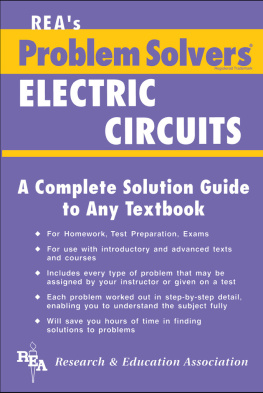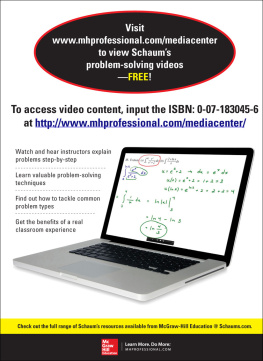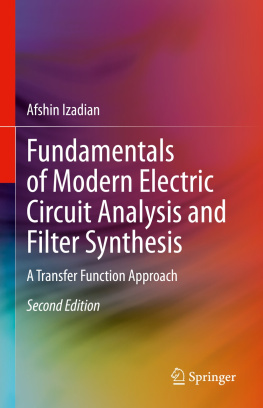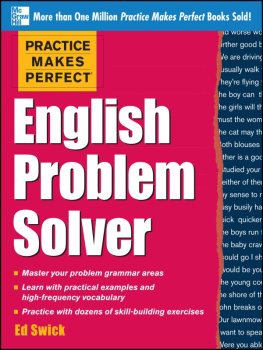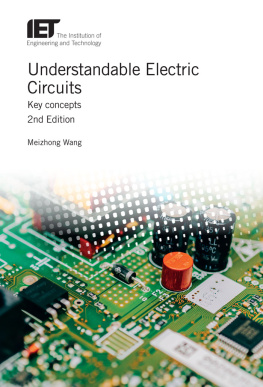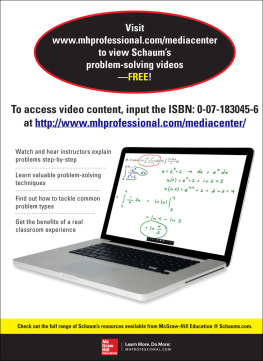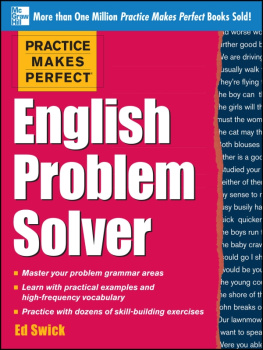Dr. M. Fogiel - The Electric Circuits Problem Solver
Here you can read online Dr. M. Fogiel - The Electric Circuits Problem Solver full text of the book (entire story) in english for free. Download pdf and epub, get meaning, cover and reviews about this ebook. year: 2004, publisher: Research $ Education Association, genre: Home and family. Description of the work, (preface) as well as reviews are available. Best literature library LitArk.com created for fans of good reading and offers a wide selection of genres:
Romance novel
Science fiction
Adventure
Detective
Science
History
Home and family
Prose
Art
Politics
Computer
Non-fiction
Religion
Business
Children
Humor
Choose a favorite category and find really read worthwhile books. Enjoy immersion in the world of imagination, feel the emotions of the characters or learn something new for yourself, make an fascinating discovery.
- Book:The Electric Circuits Problem Solver
- Author:
- Publisher:Research $ Education Association
- Genre:
- Year:2004
- Rating:3 / 5
- Favourites:Add to favourites
- Your mark:
- 60
- 1
- 2
- 3
- 4
- 5
The Electric Circuits Problem Solver: summary, description and annotation
We offer to read an annotation, description, summary or preface (depends on what the author of the book "The Electric Circuits Problem Solver" wrote himself). If you haven't found the necessary information about the book — write in the comments, we will try to find it.
The Electric Circuits Problem Solver — read online for free the complete book (whole text) full work
Below is the text of the book, divided by pages. System saving the place of the last page read, allows you to conveniently read the book "The Electric Circuits Problem Solver" online for free, without having to search again every time where you left off. Put a bookmark, and you can go to the page where you finished reading at any time.
Font size:
Interval:
Bookmark:
Dr. M. Fogiel, Chief Editor With Contributions By Gerard Kiernan, P.E.
QSS Group, Inc.
Seabrook, MD Wayne Allen
Raleigh, NC
 Research and Education Association 61 Ethel Road West Piscataway, New Jersey 08854THE ELECTRIC CIRCUITS PROBLEM SOLVERCopyright 2004, 1998, 1995, 1980 by Research & Education Association. All rights reserved. No part of this book may be reproduced in any form without permission of the publisher.Printed in the United States of AmericaLibrary of Congress Control Number 2003101384International Standard Book Number 0-87891-517-6PROBLEM SOLVER is a registered trademark of Research & Education Association, Piscataway, New Jersey 08854
Research and Education Association 61 Ethel Road West Piscataway, New Jersey 08854THE ELECTRIC CIRCUITS PROBLEM SOLVERCopyright 2004, 1998, 1995, 1980 by Research & Education Association. All rights reserved. No part of this book may be reproduced in any form without permission of the publisher.Printed in the United States of AmericaLibrary of Congress Control Number 2003101384International Standard Book Number 0-87891-517-6PROBLEM SOLVER is a registered trademark of Research & Education Association, Piscataway, New Jersey 08854In a study of the problem, Research & Education Association found the following basic reasons underlying students difficulties with electric circuits taught in schools: (1) No systematic rules of analysis have been developed which students may follow in a step-by-step manner to solve the usual problems encountered. This is brought about by the multitude of conditions and principles that may be involved in an electric circuits problem; often, the student is faced with a number of possible methods for solving a problem. To prescribe an approach to be followed for each of the possible variations would involve wading through an enormous number of rules and stepsa task that could become more burdensome than solving the problem directly, with some accompanying trial and errorto find the correct solution route. (2) Textbooks currently available will usually explain a given principle in a few pages written by a professional who has special insight into the subject matter which is not shared by students. The explanations are often written in an abstract manner that leaves students confused as to the application of the principle. In addition, the explanations given are not sufficiently detailed or extensive to make students aware of the wide range of applications and different aspects of the principle being studied.
The numerous possible variations of principles and their applications are usually not discussed, and it is left for the students to discover these for themselves while doing exercises. Accordingly, the average student is expected to rediscover that which has been long known and practiced, but not published or explained extensively. (3) Usually, the examples that accompany the explanation of a topic are too sparse and too simple to enable students to obtain a thorough grasp of the principles involved. The explanations do not provide sufficient basis to enable students to solve problems that may be subsequently assigned for homework or given on examinations. The examples are presented in abbreviated form, leaving out much material between steps and requiring students to derive the omitted material themselves. As a result, students find the examples difficult to understandcontrary to the purpose of presenting examples in the first place.
Moreover, examples are often wordy and confusing. They do not state the problem and then present the solution. Instead, they pass through a general discussion, never revealing what is to be solved for. Examples also do not always include diagrams/graphs, wherever appropriate, and thus students do not obtain the necessary training to draw diagrams or graphs to simplify and organize their thinking. (4) Students can learn this subject only by doing the exercises themselves and reviewing them in class. We believe students need to obtain experience in applying the principles so that they can see the many different ramifications that stem from each.
In doing the exercises on their own, students find that they are required to devote considerably more time to electric circuits than to other subjects with comparable credits. This is because they are uncertain about the selection and application of the principles involved. Moreover, all too often they find it necessary to discover the tricks not revealed in their textbooks or review books which make it possible to solve problems easily. As a result, students find themselves spending a great deal of time resorting to trial and error to solve problems. (5) When reviewing the exercises in the classroom, instructors typically have students take turns writing solutions on the blackboard or on a computer, and explaining them to the class. Presenters often find it difficult to explain the solutions in a manner that both holds the interest of the class and enables their classmates to follow their line of thinking.
Furthermore, the students being addressed are too busy copying the material from the board to properly take in all of the oral explanations and focus their attention on the methods of solution. This book is intended to aid students in electric circuits in surmounting the difficulties weve described by supplying detailed illustrations of the solution methods which are usually not apparent or readily available to students. We illustrate those solution methods by selecting the very problems that are most often assigned for class work and given on examinations. The problems are arranged in order of complexity to enable students to learn and understand a particular topic by reviewing the problems in sequence. The problems are illustrated with detailed step-by-step explanations, to save students the large amount of time that is often needed to fill in the gaps that are usually found between steps of illustrations in textbooks or review/outline books. The staff of REA considers electric circuits a subject that is best learned by allowing students to view the methods of analysis and solution techniques themselves.
This approach to learning the subject matter is similar to that practiced in scientific laboratories, particularly in the medical field. In using this book, students can review and study the illustrated problems at their own pace; they are not limited to the time allowed for explaining problems on the board in class. When students want to look up a particular type of problem and solution, they can readily locate it in the book by referring to the Index, which has been extensively prepared. It is also possible to locate a particular type of problem by just glancing at the material within the boxed portions. To facilitate rapid scanning of the problems, each problem has a heavy border around it. Furthermore, each problem is identified with a number immediately above the right-hand margin.
To obtain maximum benefit from the book, students should familiarize themselves with the following section, How to Use this Book. To meet the objectives of this book, staff members of REA have selected problems usually encountered in assignments and examinations, and have solved each problem meticulously to illustrate the steps that are particularly difficult for students to grasp. For outstanding effort and competence in this area, we express special gratitude to Peter Halatyn and Timothy Waters. The following persons also contributed a great deal of support and much patient work to achieve the objectives of the book:
Font size:
Interval:
Bookmark:
Similar books «The Electric Circuits Problem Solver»
Look at similar books to The Electric Circuits Problem Solver. We have selected literature similar in name and meaning in the hope of providing readers with more options to find new, interesting, not yet read works.
Discussion, reviews of the book The Electric Circuits Problem Solver and just readers' own opinions. Leave your comments, write what you think about the work, its meaning or the main characters. Specify what exactly you liked and what you didn't like, and why you think so.

